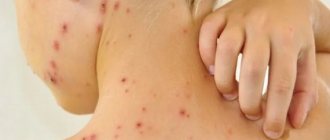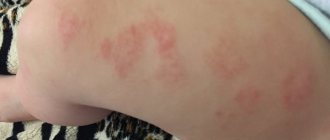Last update: 02/21/2021
Animal allergies are considered one of the most common forms of allergic reactions in the world. Research shows that the number of people suffering from allergies to animal hair, dander, feathers, fluff, saliva, excrement and sebaceous gland secretions is increasing every year.
Today, the number of people suffering from such a reaction ranges from 11 to 76.5%, depending on where they live. A form of allergy to animals is especially common in children, since the child’s immune system is very vulnerable, and the child’s body is more susceptible to sensitivity to allergens than an adult.
Why are there allergies to animals?
A pet allergy is a reaction of the human immune system to the skin, saliva or urine of an animal. It is often caused by pet hair and dead skin flakes, and less commonly by allergens called proteins and produced by the endocrine system. All allergens, regardless of type, can be airborne, can mix with dust and other substances, and accumulate on things, furniture and other surfaces, causing reaction symptoms in women, men and children. Any animal with fur can cause an allergic reaction, but most pet allergies involve dogs and cats.
Michael Miller, MD notes that most allergies are to:
- dogs and cats are caused by human hypersensitivity to proteins contained in their saliva and dander;
- rabbits, hamsters and guinea pigs - in urine.
Are there hypoallergenic animals?
Allergies can occur to absolutely any animal, and hypoallergenic animals are a myth. But there are pets that can provoke allergies less often than others.
A turtle can be a good pet option for an allergy sufferer. She has no fur, the amount of saliva and sweat is insignificant, and she is very easy to care for. But its waste products (feces) can also cause unwanted allergic reactions, so it would be ideal if a person who is not susceptible to allergies cleans up after it.
Cute animals like chinchillas are also quite hypoallergenic, because they have neither sebaceous nor sweat glands. Therefore, a chinchilla is an almost ideal option for allergy sufferers. “Almost” because it is very rare, but the reaction to chinchillas occurs.
Hairless guinea pigs are also a good option.
A Bichon Frize dog may also be suitable for a person with allergies. Despite the fact that their fur is thick and dense, they shed very little of it. But the Yorkshire Terrier, contrary to popular belief, can cause allergies with the same probability as dogs of other breeds.
What are the symptoms of animal allergies?
Symptoms of allergies to animals that live in homes make themselves felt immediately after interacting with them, due to the presence of allergens near the allergic person. The occurrence of an uncharacteristic reaction of the body is indicated by:
- repeated sneezing;
- skin rashes;
- sinus congestion or nasal discharge;
- red eye syndrome, lacrimation;
- cough, wheezing and shortness of breath;
- discomfort in the chest.
The appearance of rashes and other indicated symptoms on the skin may indicate not only an allergy to animals, but also other diseases of internal organs and systems. To determine the cause of their occurrence, you need to consult a doctor.
Causes of allergies
Our body is designed in such a way that it must constantly withstand a certain level of threats. If there are no threats, the immune system begins to react to completely harmless agents (allergens), and often to the cells of its own body (autoimmune diseases).
Our immune system produces antibodies to specific allergens as if they are dangerous, even when they are not. For example, by inhaling an allergen, the immune system reacts to the ingested agent and causes a local inflammatory reaction in the nasal passages and lungs, and regular and prolonged exposure to the allergen can lead to bronchial asthma.
Will cat allergies go away?
There is no scientific evidence that a cat allergy will go away over time. If it is not possible to eliminate the allergen, an allergist will help reduce the symptoms of an allergic reaction using antihistamines.
Dr Kerry Hancock, a member of the National Asthma Council of Australia, says that all cat breeds produce allergens, regardless of whether they have fur or how long it is. Typically, male cats produce more allergens than female cats. Neutering cats helps reduce the occurrence of allergic reactions.
Treatment
Doctors use the following medications to treat allergic conditions:
- antihistamines;
- enterosorbents;
- corticosteroids;
- decongestants.
Antihistamines: Tavegil, Claritin, Diphenhydramine.
Corticosteroids are especially effective for allergic symptoms, however, they are not safe. The drugs have a number of side effects and can only be prescribed by a specialist who will tell you how allergies to cats manifest in children and how to help your child at home.
How does a dog allergy manifest?
If communication with a dog leads to unpleasant sensations (sneezing, runny nose, nasal congestion), you should consult a doctor to rule out an allergy. Some people develop skin rashes in areas where saliva or dog claw marks remain. All dogs produce allergens (proteins) found in their fur, dander, and urinary system. According to the American College of Allergy, Asthma and Immunology, existing research does not support the conclusion that dogs are hypoallergenic. According to statistics, 37-47% of American families have dogs. In our country, according to a 2022 social survey conducted by Kyiv, about 10% of the population has dogs.
At the same time, some breeds are conditionally classified as hypoallergenic. These are poodles, Can Diaguas or Portuguese Wasserhunds, and some types of terriers. However, there is no scientific basis for such a division between breeds. One study from 2011 compared dust samples from homes with dog breeds that are conventionally classified as hypoallergenic to dust samples from homes with dog breeds that are not classified as hypoallergenic. The level of dog allergenicity in all houses was almost the same.
The dog carries a lot of particulate matter on its coat, including pollen, house and street dust, which provoke an immune response to the irritant. In this case, the problem is not in the dog, but in substances that, for various reasons, get and remain in its fur. Only an allergist can determine the causes of any allergic reaction to animals. To do this, a test is performed using a small amount of dog allergen extract (saliva, fur hairs, or other material taken from the animal). The extract is applied to a person's skin and a puncture is made using a small sterile probe, allowing the liquid to seep under the skin. If swelling, redness or other signs of an allergic reaction form at the puncture site within 15-20 minutes, the person is diagnosed with an allergy to dogs.
Good news for allergy sufferers!
In July 2022, scientists from the Purina research division, together with allergists from the John Washington University School of Medicine, announced a new additive to cat food that, with long-term use, deprives the animal of the ability to cause allergies in humans. The effectiveness of the supplement was confirmed in laboratory tests and in experiments with cats and people with allergies. Perhaps soon the new food will become a truly effective solution for those who love cats, but cannot yet be near them.
In any case, when getting a pet, you need to remember that this is for many years and carefully weigh your options!
Health to you and your pets! Department of Dermatology ICC "PiK"
Can dog allergies develop over time?
Allergies to dogs can develop over time. The reasons for what is happening are associated with the action of various factors acting alone or simultaneously. These include:
- Lifestyle;
- decreased immunity under the influence of stress, a developing disease, or another allergen that increases the load on the immune system;
- insufficient contact with allergens, which leads to a weakening of the body’s protective functions;
- ecology;
- other factors.
There is a hygiene hypothesis according to which, due to excessive human concern for cleanliness and sterility, doctors are more likely to diagnose allergies, asthma, intestinal inflammation and autoimmune diseases. Erica von Mutzius, a pediatric allergist at the University of Munich and one of the first doctors to study the hygiene hypothesis, concluded that lack of exposure to bacteria, viruses and allergens in children prevents the full development of the immune system. As a result, the likelihood of developing immune disorders in adulthood increases.
According to an American study, living with animals during the first years of a child’s life strengthens the immune system. The less often children come into contact with animals, the more exposed they are to allergens.
Should I get rid of an animal while expecting a baby?
Sometimes adults ask about the impact of pets on the home when they are thinking about or expecting a child. A 2012 meta-analysis concluded that "practitioners should not be advised to avoid or acquire pets for the primary prevention of asthma or allergic rhinitis in children." The evidence does not support recommending that patients remove animals from the home because they are expecting a child and hope to reduce that child's risk of allergic diseases. Likewise, it would be inappropriate to encourage families to have pets for the sole purpose of preventing allergic diseases. Thus, the risk of allergic diseases in future children should not influence a family's decision to have pets.
Can a dog allergy go away?
An allergy to dogs does not go away without treatment, which is selected by an allergist after examining the patient. If you are allergic to dogs, symptoms include:
- Nasal congestion and runny nose are treated with steroid nasal sprays, oral antihistamines and other medications;
- watery eyes and redness of the eyes - with antihistamine eye drops.
If prescribed by a doctor, dog allergy vaccinations are recommended to help the immune system become more resistant to allergens.
Diagnostics
After a thorough examination of the patient and collection of anamnesis, the doctor in most cases will prescribe additional research methods, namely: blood test, urine test, blood biochemistry, immunogram and special skin tests.
How is a skin test performed? A small amount of purified extracts of various allergens is applied to the skin in the forearm area. At the site where the solution is applied, a puncture is made with a needle or an incision with a scarifier. The test results are assessed after 15 minutes. The most common side effects of the test include itching and redness of the skin, which go away on their own within an hour.
We will talk further about how to determine if a child is allergic to a dog and what parents should do as first aid.
Are animal allergies inherited?
Allergies to pets in individual family members begin to develop from the moment they appear in the house. The body's susceptibility to allergens can occur for various reasons: due to low immunity, stress, and the development of inflammatory processes. As a result, the immune system cannot cope with the effects of allergens, and their prolonged presence in the house leads to the formation of genetic hypersensitivity to certain irritants. Thus, allergies can be inherited. However, this does not mean that a person should be isolated from communication with animals. If allergy symptoms appear, you need to seek help from a doctor and determine the cause of the allergic reaction.
Clinical researches
The conducted clinical study proves the high efficiency, safety and tolerability of products for daily skin care of children with mild and moderate forms of atopic dermatitis and during remission, accompanied by a decrease in the quality of life of patients. As a result of therapy, a decrease in the activity of the inflammatory process, a decrease in dryness, itching and flaking was noted.
For example, the following has been clinically proven:
- Emulsion "La-Cri" moisturizes and nourishes the skin, relieves itching and irritation, soothes and restores the skin.
- Cream "La-Cri" for dry skin eliminates dryness and flaking, retains the skin's own moisture, protects the skin from wind and cold
- La-Cri cream for sensitive skin reduces itching and irritation, relieves skin redness, moisturizes and gently cares for the skin.
Sources:
- Sukolin Gennady Ivanovich, Clinical dermatology. A short guide to the diagnosis and treatment of dermatoses, Notabene, 2017
- Rodionov A.N., Zaslavsky D.V., Sydikov A.A. Edited by Professor A.N. Rodionova, Dermatology: an illustrated guide to clinical diagnostics according to Professor Rodionov A.N., M.: Granitsa. 2022.
- Churolinov Petr, Herbal medicine in dermatology and cosmetics, Medicine and physical education, 1979
How to get rid of an allergy to animal fur?
To get rid of an allergy to animal fur, you need to stop contacting the irritant. If for some reason this cannot be done, you need to:
- minimize the time you spend interacting with your pet;
- keep a cat or dog outside or in a separate room;
- do not allow the pet to touch the bedding, clothing, or personal hygiene products of the allergic person;
- use air filters;
- carry out wet cleaning more often using detergents;
- To reduce allergy symptoms, use nasal sprays and antihistamines as prescribed by your doctor.
After interacting with animals, family members may carry particles of animal hair on themselves. To minimize the symptoms of a wool allergy on clothing in an allergic person, we encourage family members to shower and change clothes.
The effect of allergens is reduced by regular bathing of pets. To do this, you need to use special detergents, but do not forget that they only temporarily reduce the effect of allergens.
The Norwegian Asthma and Allergy Association reports that there are no recommendations that dogs or cats should not be owned to prevent allergies, even if there is no allergy sufferer in the family. The results of many studies show that pets neither increase nor decrease the risk of developing allergies. At the same time, some studies say that keeping pets in the house protects against allergies. If you don't know if you or your family has a pet allergy, get an allergy test done before you bring your pet into your home.
3
4
13
Article rating:
3.1 out of 5 based on 10 ratings
Author: Yatsishena Victoria Anatolyevna
Children's allergist. Highest category. Work experience 21 years.
Prevention
Of course, the best solution would be complete isolation from the allergen. But if you are not ready to part with your pet, the following measures will help minimize contact with the irritant protein:
- daily wet cleaning;
- daily ventilation of the room, especially before bedtime;
- washing hands after contact with animals;
- using an air purifier;
- Do not allow animals into the room of an allergic person.
If you have any questions, please make an appointment. During a personal conversation, the doctor will answer them and tell you whether cats do not cause allergies. Registration takes place by phone and online.
Related services: Pediatric allergology
Problems are growing
Alas, the miracle did not happen, and communication with the pet suddenly began to cause a runny nose and cough. What to do in this case? “I have met owners with allergies,” says veterinarian Natalya Bolshova . – Moreover, I myself am the owner of a charming cat, although I suffer from allergies. True, in a strange form - I can’t stand some older, uncastrated males. For now I make do with antihistamines, wash my face, put on a protective mask and continue taking them. But I won’t risk bringing an old cat into the house, since allergies tend to only get more complicated.”










